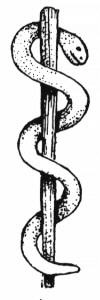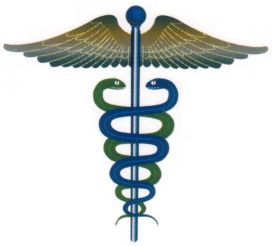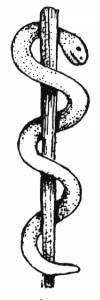|
||
 |
![]() he constellation, Ophiuchus, has
been known since ancient times, and is better
known as Serpentarius, the Serpent Holder.
It is included in the list of 48
constellations described by Ptolemy. Ophiuchus
is depicted as a man handling a serpent; his
body dividing the large snake into two parts,
giving way to the symbol used today as an
Asclepius - the medical staff. Astrologers have not
included Ophiuchus in the wheel of
Astrological signs because the Sun spends only
about nineteen days in this 13th sign of the
Mazzaroth. Not that there wasn't a 13th sign
in the Heavens, but as far as Astrologers were
concerned, the Sun traveled from the
constellation 'Scorpius' and then proceeded
directly into the sign of Sagittarius. In
reality, this was not the case. The Sun, for
19 days of the year, travels through the star
constellation 'Ophiuchus' before entering
Sagittarius from Scorpius - see chart below.
thus The sign of Ophiuchus is patterned
after the original 'Serpent Holder', Enki,
a Sumerian god.
he constellation, Ophiuchus, has
been known since ancient times, and is better
known as Serpentarius, the Serpent Holder.
It is included in the list of 48
constellations described by Ptolemy. Ophiuchus
is depicted as a man handling a serpent; his
body dividing the large snake into two parts,
giving way to the symbol used today as an
Asclepius - the medical staff. Astrologers have not
included Ophiuchus in the wheel of
Astrological signs because the Sun spends only
about nineteen days in this 13th sign of the
Mazzaroth. Not that there wasn't a 13th sign
in the Heavens, but as far as Astrologers were
concerned, the Sun traveled from the
constellation 'Scorpius' and then proceeded
directly into the sign of Sagittarius. In
reality, this was not the case. The Sun, for
19 days of the year, travels through the star
constellation 'Ophiuchus' before entering
Sagittarius from Scorpius - see chart below.
thus The sign of Ophiuchus is patterned
after the original 'Serpent Holder', Enki,
a Sumerian god.
![]() he signs of the Zodiac
are for the most part, the highway, or path on
which the Sun takes it's yearly journey across
the heavens - as it would appear to
Earthlings. These signs are actually star
constellations occupying space in which the
Sun appears to travels in an earth year. The
original twelve signs/constellations: Aries,
Taurus, Gemini, Cancer, Leo, Virgo, Libra,
Scorpio, Sagittarius, Capricorn, Aquarius, and
Pisces are quite familiar to everyone,
however, the thirteenth sign and
constellation, [Ophiuchus], is in fact, not
well known. To acknowledge a 13th sign
now would seem awkward for astrologers, who
like the tidiness of 12 signs that rule over
the 12 houses of the Zodiac. The heavens are
alive and they do change after a few thousand
years and the astrologer who wants to maintain
accuracy must change along with the signs in
the heavens.
he signs of the Zodiac
are for the most part, the highway, or path on
which the Sun takes it's yearly journey across
the heavens - as it would appear to
Earthlings. These signs are actually star
constellations occupying space in which the
Sun appears to travels in an earth year. The
original twelve signs/constellations: Aries,
Taurus, Gemini, Cancer, Leo, Virgo, Libra,
Scorpio, Sagittarius, Capricorn, Aquarius, and
Pisces are quite familiar to everyone,
however, the thirteenth sign and
constellation, [Ophiuchus], is in fact, not
well known. To acknowledge a 13th sign
now would seem awkward for astrologers, who
like the tidiness of 12 signs that rule over
the 12 houses of the Zodiac. The heavens are
alive and they do change after a few thousand
years and the astrologer who wants to maintain
accuracy must change along with the signs in
the heavens.
![]() he constellation of Ophiuchus is the
only sign of the Zodiac which is linked to a
real man. This man lived in ancient
he constellation of Ophiuchus is the
only sign of the Zodiac which is linked to a
real man. This man lived in ancient
The keyword descriptions seen below originated
with Betty Rhodes and are the attributes for
the 13th sign of the Zodiac - Ophiuchus:

|
LIST OF KEY WORDS
DESCRIBING THE SIGN OF OPHIUCHUS
|
| ACTUAL TRUE ZODIAC AS OF 2000 AD
|
Of the sign Ophiuchus:
"Thou shalt be over my house, and according unto thy word shall all my people be ruled: only in the throne will I be greater than thou. And he made him to ride in the second chariot which he had; and they cried before him, Bow the knee: and he made him ruler over all the land of Egypt. And Pharaoh said unto Joseph, I am Pharaoh, and without thee shall no man lift up his hand or foot in all the land of Egypt." GEN 41:40-44
TO LEARN MORE ABOUT THE 'SNAKE' IN THE GARDEN OF EDEN, THE 'SNAKES' OF IRELAND, AND THE ASSOCIATION WITH THE MEDICAL PROFESSION, READ:
"Keeper of the Celtic Secrets" by Betty Rhodes - see http://the-red-thread.net for info.
 The Caduceus [left] depicts two
entwined snakes set upon a rod, and was the
ancient symbol of Hermes, the Greek god of
merchants. Today it is a common and popular
symbol of the medical and allied professions. If
you have ever sat in waiting
room chairs of a doctor's room
reading a medical journal, then you have come
across the Caduceus.
The Caduceus [left] depicts two
entwined snakes set upon a rod, and was the
ancient symbol of Hermes, the Greek god of
merchants. Today it is a common and popular
symbol of the medical and allied professions. If
you have ever sat in waiting
room chairs of a doctor's room
reading a medical journal, then you have come
across the Caduceus.Asclepius (an ancient greek physician who was deified as the god of medicine) is traditionally depicted as a bearded man wearing a robe that leaves his chest uncovered and holding a staff with his sacred single serpent coiled around it
 symbolizing renewal of youth as the serpent
casts off its skin. The single serpent staff
also appears on a Sumerian vase of c. 2000 B.C.
representing the healing god Ningishita, the
prototype of the Greek Asklepios.
symbolizing renewal of youth as the serpent
casts off its skin. The single serpent staff
also appears on a Sumerian vase of c. 2000 B.C.
representing the healing god Ningishita, the
prototype of the Greek Asklepios.The probable medical origin of the single serpent around a rod: In ancient times infection by parasitic worms was common. The filarial worm Dracunculus medinensis aka "the fiery serpent", aka "the dragon of Medina" aka "the guinea worm" crawled around the victim's body, just under the skin. Physicians treated this infection by cutting a slit in the patient's skin, just in front of the worm's path. As the worm crawled out the cut, the physician carefully wound the pest around a stick until the entire animal had been removed. It is believed that because this type of infection was so common, physicians advertised their services by displaying a sign with the worm on a stick.
see: Imhotep as Joseph for additional Ophiuchus description
To read more on the 13th sign of the Zodiac - Ophiuchus use these links:
HOME
